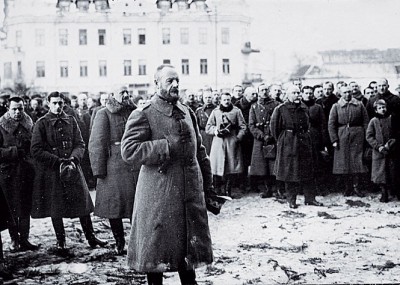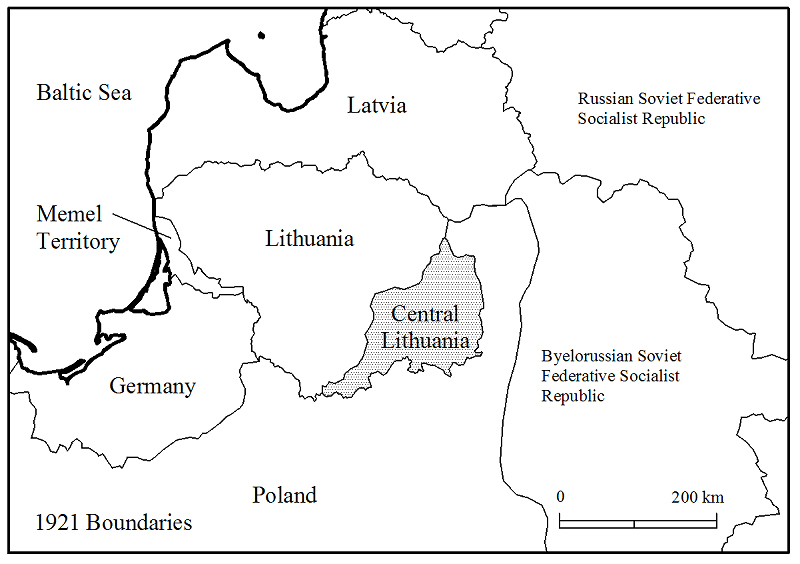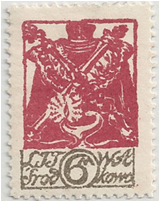ALBUM – view my Central Lithuania album
TRANSITION CHART for the Baltics
Fast Facts
Region: Baltics
Group: Baltic Countries
Classification: Puppet State
Prior Regime: Lithuania
Key Dates:
1920, Oct 12 – State of Central Lithuania proclaimed
1922, Jan 8 – Civil elections were held (most consider a sham)
1922, Feb 20 – Central Lithuania Parliament voted to become part of Poland
1922, Mar 24 – Central Lithuania annexed into Poland
Following Regime: Poland
Scott Catalogue: (Central Lithuania) #1-58, B1-B19, J1-J5
Pick Catalogue: none
History

Due to its strategic position between Russia and the rest of Europe, the Baltic region was a battleground for the political machinations of the great empires of Europe throughout the 18th, 19th and 20th centuries. After the fall of the Polish/Lithuanian Commonwealth, where Lithuania was a Grand Duchy (1569–1795), the area became a part of the Russian Empire until its fall in 1918.
At the end of World War I, the area of the former Grand Duchy of Lithuania was divided between the Republic of Poland, the Belarusian National Republic, and the Republic of Lithuania. For the next two years, the area saw frequent conflict with the city of Vilnius changing hands multiple times until the League of Nations intervened. A cease fire was ultimately signed on 7 Oct, 1920, with the city of Vilnius (Wilno in Polish) to become a part of Lithuania at12:00 on 10 Oct, 1920.
This never happened, for on October 8, General Lucjan Żeligowski and the 1st Lithuanian-Belarusian Infantry Division, along with local Polish inhabitants launched a surprise attack on the weak Lithuanian forces driving them out of the area. Poland disclaimed all responsibility for the action, maintaining that Żeligowski had acted entirely on his own initiative (which was later proved to be a deception by Poland). Gen. Żeligowski proclaimed a new state, the Republic of Central Lithuania. Few countries, other than Poland recognized the state.
For eighteen months, Central Lithuania, with the support of Poland, served as a buffer between Poland and Lithuania which maintained a claim on the area. Soon after the action, Żeligowski announced the creation of a provisional government with the announcement that elections would take place in Jan 1921. Intense negotiations continued through the League of Nations, which never resulted in an agreement. With the drumbeats of another war brewing and against the protests of the Lithuanians, Żeligowski passed the control of the government to civil authorities and an election was held on 8 Jan, 1922. The vote, which was boycotted by the most of the Lithuanian and Jewish population, was won by the Polish factions who took control of Parliament. While the elections were never recognized by international bodies, the Polish factions gained control of the Parliament and, on 20 Feb, 1922, voted to become part of Poland. Poland accepted and on 24 Mar, 1922, Central Lithuania became part of Poland. Lithuania refused to accept Polish authority, and continued to maintain that the area rightfully belonged to Lithuania. Tensions remained extremely high until the Soviet Union invaded Eastern Poland in Sept 1939 and Lithuania in June 1940, based on secret agreement with Nazi Germany called the Molotov–Ribbentrop Pact. After the invasion, the Soviet Union occupied and annexed Lithuania into the USSR and Vilnius was returned to Lithuania to become its capital.

Stamps
 ALBUM
ALBUM
The first stamps of Central Lithuania were issued on November 23, 1920 and consisted of surcharged stamps of Lithuania. The stamps were surcharged in Markka, which was the currency of Poland, a central eagle design, and the words “Srodkowa Litwa” and “POCZTA” , which is Polish for Central Lithuania and postage. Four values were issued (2m, 4m, 6m and 10m,) and were on various stamps for a total of 10 different stamps. Many printing varieties exist, including come inverted surcharged.
Shortly thereafter, definitive stamps were issued depicting the coat of arms of the region. Three values were issued (25r, 1m and 2m) and were printed on various paper types both perforated and imperforated. In 1921, the three stamps were issued in three different colors. The stamps were also issued in 1921 as semi-postal stamps, overprinted “NA SLASK “, which means “For Silesia” and were surcharged with an additional 2 markka. Funds were intended to assist the Polish side of the plebiscite what was being held in Upper Silesia.
Three sets of commemorative stamps were issued in the short history of the country; all of them were rather simple and crude in design. Generally they depicted buildings and landmarks around Vilinius, or images of Gen. Żeligowski, or Polish royalty and heroes. In 1921, some of the first set commemoratives issued were surcharged as semi-postal stamps. Additionally, a set of crude postage due stamps were issued and used in 1921-22.
Banknotes
None, Polish banknotes were used.
Links
Central Lithuania at BRC Stamps
Środkowa Litwa – stamps of Central Lithunia at Stamp Collecting Blog
Polish-Lithuanian War





Hi,
I have an imperforated Coat of Arms, value 5. It’s definitely a 5 and not a 6. Any rough idea of possible value? Thanks